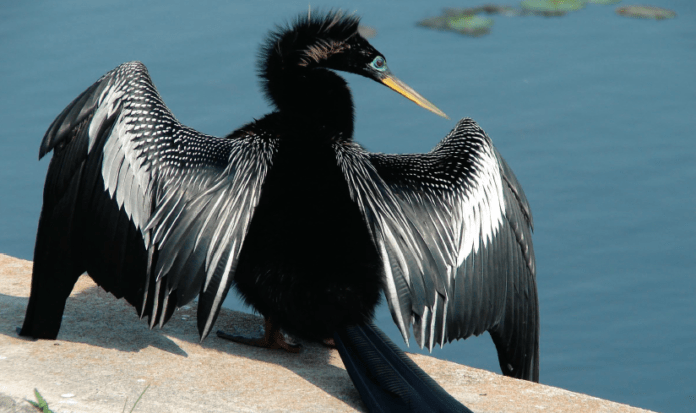MICHAEL GIVANT
Contributing Columnist
givant@lbknews.com
In the heart of an industrial park a mile from the 300 acres of wetlands called Celery Fields is a secluded, large body of water. On shore an anhinga, partly in shadow, dries its wings. The bird nicknamed the “water turkey” has a long bill and long tail. Its black back and wings are matted with silvery white lines. Its large dark mustard-colored, webbed feet look as if they are made from heavy-duty canvas from an Army-Navy store. It’s a sight.
Standing on a ridge my wife, two close friends and I look at the water and see some great egrets, a great blue heron, a few cormorants and some mallards. Scanning the trees on the opposite shore, which are partly in shadow, we find eight perching anhinga. The males are black while the females have a black body and a buffy head, neck and breast. Complementary opposites. Each has a slivery, white-lined pattern on their back and wings. That, combined with the lines of their long-pointed bills, long straight-edged tails and lean appearance give them a striking appearance.
Our next stop, the Celery Fields, is undergoing massive renovation. They are filled with more water and birds than I’d ever seen here before. Among the aquatic plants are great egrets, some wood storks and an army of coots. On the grass are some lean and tawny female boat-tailed grackles. Fat City. Now in late afternoon, we go to a corner of the huge irrigated area to a veritable avian feast of smaller birds.
There are yellowlegs, sandpipers so named because of the color of their long legs. Watch these elegant birds feeding for a while and it’s hard not to become smitten by them. One repeatedly dips its bill in to the smooth-as-glass water, creating a series of concentric ripples.
Closer to shore is another group of sandpipers, short-billed dowitchers. These 11-inch birds have disproportionately long, lance-like bills. The plump, brown-bodied short-bills have their heads buried to the base of their necks, as they feed fast in the soft mud below the water’s surface. Beyond them is a group of boat-tailed grackles, which are larger than their female counterparts that we saw before on the grass. The blue sky is suddenly alive with flying black specks. Coming closer it’s apparent that they are boat-tailed grackles, more than 100 of them. Landing in the water near their brothers without a splash, they quickly start feeding.
Killdeer are plovers with two prominent black bands around their upper breast. These birds sometimes feign having a broken wing to draw predators away from their nest site. One is walking across the road but is not doing the broken wing act. It suddenly takes off flying in a wide arc, showing the under parts of its wings, which are white as snow. It calls as it gets out of sight over the water. Charming.
As the setting sun becomes an orange ball in the sky we walk along the road. In the molten looking water, among the aquatic vegetation, are two gray, bulky-bodied sandhill cranes with tiny red-capped heads. The scene has the delicacy of a Japanese painting, as we watch the long-legged cranes move with the elegance of Geishas. On an island are two great blue herons, one of which lifts off and languidly flies.
On the island’s other side are a dozen wood storks, birds that are on the endangered species list. All are standing but one and looking serenely in the same direction. Perhaps that serenity comes from not being in diminishing wetlands. Beyond them appear to be some glossy ibises. Last week there were two-dozen glossies here, most of which looked black, perhaps an effect of afternoon light. I want to watch this effect but there’s no time. It’s sundown at the Celery Fields, which means the cranes should be flying in.
One of the two cranes in the water has its bill open and is letting out a series of short guttural sounds. Soon the other follows suit with higher-pitched, longer and louder sounds. Are they calling to the others? Two cranes, one carrying a stick in its bill, appear, wing tips splayed and long necks extended.
To our other side and from a different direction come three more cranes flying in a wide arch. Going into their descent the cranes go into a tight spiral, their wings slightly cupped, giving them the look of parachutes. They join others in the water and are soon jumping up and down in what may be a courtship display. My wife points to some cranes, saying that they are right in front of us. Where? Following her finger, they are directly in front of us, exactly where she said. I see the brown streaks on their bulky bodies for the first time, up close and not in a field guide.
Across a road is a field with grazing cows. Last week among them were two horned steers and numerous cattle egrets, birds that eat insects stirred up by the cattle. As I cross a sloping road, going toward some tan, dried grasses, two fast flying cranes appear out of nowhere, moving at a slight upward angle. There are some cows, one of which has a mildly comic face as it looks at an egret.
The orange-hued remains of the sun won’t last as twilight is descending. Time to go. The Celery Fields are swimming with birds and I’ll be back soon for a better look at everything. It’s my hope that I’ll see one of those cattle egrets riding on the back of a steer. It could give new meaning to the old phase “ride ’em cowboy.”

